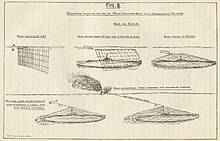Network lock
Block network (also blocking networks ) are military barriers of minor importance which are mainly used in shallow waters, for example in front of smaller and medium-sized port facilities . The network closures are primarily intended to repel combat divers , submarines , ships and torpedoes or make it more difficult to penetrate the ports in order to gain time for further defense.
The weighted nets made of plastic with reinforcement made of thin, austenitic wires are laid across the port entrance. The meshes of the nets are so tight that neither people nor torpedoes can get through them. Since torpedoes are usually equipped with an impact fuse , the risk of an explosion in the network is low.
For the passage of ships, depending on the construction, the net barrier is either folded away towards the sea and laid on the ground or pulled to the side with the help of a tug . The establishment, monitoring, maintenance and operation of German network barriers in important ports was the responsibility of the barring command offices set up by the navy during the Second World War .
Steel nets, which were still used in the First and Second World Wars, in particular to cordon off submarine bunkers and sea ports, are practically no longer used today because they are too heavy and unwieldy.
The fact that nets do not offer 100% security to protect berths was shown in Scapa Flow , where, despite multiple rows of nets, the German submarine U 47 managed to penetrate the base, shoot down its torpedoes and escape from the base again.
In June 2007, a 4.5 km long cordon off the Baltic Sea resort of Heiligendamm was used on the occasion of the summit meeting of the G8 heads of state and government .
See also
Web links
- Report on the former network closure (1918) in the port of Pula (page 5) (PDF file; 986 kB)


